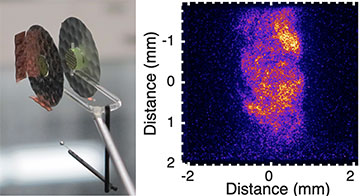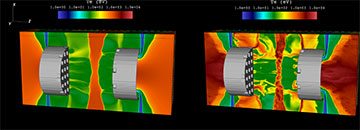
Left: Photo of the turbulent dynamo target deployed at the National Ignition Facility (NIF). The experimental target consists of two foils and a pair of grids, held together by cylindrical shields. Each target is about the size of a penny. Right: X-ray image of the turbulent plasma generated in the experiments, taken at 28 ns after the lasers fire. The hot plasma emits soft X-rays, which enable the researchers to characterize the properties of the turbulent flow and measure the fluctuations of electron temperature that revealed the strong suppression of heat transport. [Image: National Ignition Facility Operations Team]
Hot, turbulent, tenuous plasma fills gargantuan galaxy clusters that stretch across large regions of the universe, but scientists don’t yet know how such regions retain their heat. An international team of researchers employed part of the world’s most powerful laser facility to re-create the extreme conditions inside these clusters.
By generating a small but turbulent plasma field at the focus of the National Ignition Facility (NIF), USA, the scientists found that heat transport within the plasma is much less than expected (Sci. Adv., doi: 10.1126/sciadv.abj6799). Electrons within the plasma spiral along tangled magnetic-field lines rather than colliding with each other, so pockets of heat persist without escaping, the researchers discovered.
Exploring astrophysical conditions
Though hydrogen fusion ignition is NIF’s primary goal, astrophysicists can also get some experimental time with the laser system to explore the physics of plasmas that exist in stars and other astronomical objects, according to the website of Lawrence Livermore National Laboratory, which houses the NIF.
NIF has 192 powerful phosphate-glass lasers that, when fired together, generate up to 2 MJ of energy concentrated on a tiny target. However, the plasma replica required only slightly more than half of the NIF laser arsenal, according to Gianluca Gregori, the principal investigator of the galaxy-cluster experiment. “NIF was designed to utilize all 192 beams for fusion experiments—but our experiment uses a different target orientation and so not all the beams have a clear view of the foils (or capsule) we want to illuminate,” explains Gregori, a physics professor at the University of Oxford, UK.
The apparatus where the plasma action took place consisted of two thin disks connected by two plastic grids and a gas-filled capsule. The researchers blasted the two disks with 96 frequency-tripled 351-nm laser beams. The grids, with 300-μm wires spaced 300 μm apart, generated turbulence within the capsule.
After filling the capsule with a mixture of deuterium and helium-3 gases, the scientists hit it with 60 frequency-tripled laser beams delivering about 43 kJ in just 900 ps. Another four of the laser beams served as an optical Thomson-scattering probe to measure the average electron density within the briefly created plasma. (In some experimental runs, the team replaced that probe with a backscatter system that measured the reflected light from those four beams to quantify the turbulent velocity in the plasma.)
No collision, less heat conduction
FLASH simulations of the turbulent dynamo platform with Spitzer thermal conductivity turned on (left) and off (right), showing the electron temperature in electron volts. The scale uses the plasma physics convention for temperature; 1 eV divided by the Boltzmann constant equals 11,605 K. The strong magnetization of the plasma achieved in the experiments significantly suppresses the thermal conduction. This, in turn, results in intense fluctuations of the electron temperature (right), which are reproduced in the FLASH simulation. [Image: Y. Lu, University of Rochester] [Enlarge image]
Although the researchers had previously used the OMEGA laser facility at the University of Rochester, USA, Gregori says the group needed the energy that NIF provides to generate the large electron velocities that result in strong turbulence and magnetic fields within the plasma. The scientists used FLASH, a computational package from Rochester, to design the experimental configuration and to interpret the results.
Despite the huge size-scale differences between a galaxy cluster and an 860-μm-diameter capsule, Gregori is confident that the microphysics of both is similar. “The important factor here is the ratio of the collisional mean free path to the Larmor radius,” he says. “The former is the distance between two collisions and the latter is the circular orbit that an electron makes around a magnetic-field line.”
In both galaxy clusters and in the center of NIF, this ratio is large—meaning that electrons move around field lines and do not collide, Gregori says. Because electrons don’t collide, they don’t conduct heat very well, either.
Months-long simulations
According to Gregori, the team has been working on these experiments since NIF opened in 2010. Besides the experimental difficulty, each of the numerical simulations takes several months to perform. Gregori’s team seeks more NIF time to try to understand how energetic particles such as cosmic rays perform in hot, diffuse plasmas.
The team includes scientists from the universities of Chicago, Rochester, Princeton and Stanford, USA; Lawrence Livermore National Laboratory; and from the United Kingdom, France, Germany and the Republic of Korea.

